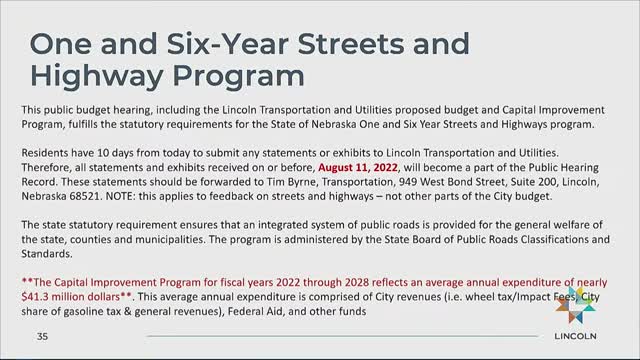City budget boosts transportation and infrastructure funding by millions
August 05, 2024 | Lincoln, Lancaster County, Nebraska

This article was created by AI summarizing key points discussed. AI makes mistakes, so for full details and context, please refer to the video of the full meeting. Please report any errors so we can fix them. Report an error »

In a recent government meeting, officials outlined significant budgetary plans for Lincoln's infrastructure, focusing on streets, water, and waste management. The proposed capital improvement plan (CIP) for fiscal years 2024 through 2030 allocates an average annual expenditure of approximately $41.3 million, primarily sourced from city revenues, gas tax, and federal aid.
Transportation funding is set to increase by nearly $3 million in the first year, totaling $49.9 million. However, the expiration of the Lincoln on the Move quarter-cent sales tax in September 2024 is expected to reduce available funds by $37.5 million, prompting discussions on whether the community would support renewing this tax to maintain investment levels.
The budget also emphasizes pedestrian safety and accessibility, with a $1.57 million annual investment in sidewalk repairs and ADA improvements. Transit services are highlighted for their role in providing stable employment and reducing traffic congestion through the use of natural gas and electric buses.
Water infrastructure remains a priority, with a proposed $215 million investment in the Water 2.0 project aimed at ensuring a sustainable water supply for Lincoln's projected growth of 115,000 residents by 2050. This includes enhancements to existing water mains and the replacement of lead service lines. The budget anticipates a modest increase in water and wastewater rates, which remain competitive compared to regional averages.
Solid waste management is also addressed, with a $44.2 million investment planned over six years. This includes the opening of a new landfill cell, which requires a significant upfront investment of $10 million. Fee increases for landfill and transfer station services are expected, marking the first adjustments since 2019.
Overall, the meeting underscored the city's commitment to maintaining and improving essential services while engaging the community in discussions about future funding mechanisms.
Transportation funding is set to increase by nearly $3 million in the first year, totaling $49.9 million. However, the expiration of the Lincoln on the Move quarter-cent sales tax in September 2024 is expected to reduce available funds by $37.5 million, prompting discussions on whether the community would support renewing this tax to maintain investment levels.
The budget also emphasizes pedestrian safety and accessibility, with a $1.57 million annual investment in sidewalk repairs and ADA improvements. Transit services are highlighted for their role in providing stable employment and reducing traffic congestion through the use of natural gas and electric buses.
Water infrastructure remains a priority, with a proposed $215 million investment in the Water 2.0 project aimed at ensuring a sustainable water supply for Lincoln's projected growth of 115,000 residents by 2050. This includes enhancements to existing water mains and the replacement of lead service lines. The budget anticipates a modest increase in water and wastewater rates, which remain competitive compared to regional averages.
Solid waste management is also addressed, with a $44.2 million investment planned over six years. This includes the opening of a new landfill cell, which requires a significant upfront investment of $10 million. Fee increases for landfill and transfer station services are expected, marking the first adjustments since 2019.
Overall, the meeting underscored the city's commitment to maintaining and improving essential services while engaging the community in discussions about future funding mechanisms.
View full meeting
This article is based on a recent meeting—watch the full video and explore the complete transcript for deeper insights into the discussion.
View full meeting
